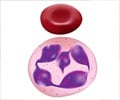- Gene editing may be a new treatment for sickle cell disease.
- It has been used successfully to repair 20 to 40 percent of cells in sickle cell patients.
- Gene editing implies the correction of sickle cells to return to normal healthy shape.
Gene editing has been used successfully to repair 20 to 40 percent of stem and progenitor cells taken from the peripheral blood of patients with sickle cell disease, according to Rice University bioengineer Gang Bao. Bao, in collaboration with Baylor College of Medicine, Texas Children's Hospital and Stanford University, is working to find a cure for the hereditary disease. A single DNA mutation causes the body to make sticky, crescent-shaped red blood cells that contain abnormal hemoglobin and can block blood flow in limbs and organs.
Bringing deformed cells to shape
"Sickle cell disease is caused by a single mutation in the beta-globin gene (in the stem cell's DNA)," he said. "The idea is to correct that particular mutation, and then stem cells that have the correction would differentiate into normal blood cells, including red blood cells. Those will then be healthy blood cells."
Bao's lab collaborated with Vivien Sheehan, an assistant professor of pediatrics and hematology at Baylor and a member of the sickle cell program at Texas Children's, to collect stem and progenitor cells (CD34-positive cells) from patients with the disease. These were then edited in the Bao lab with CRISPR/Cas9 together with a custom template, a piece of DNA designed to correct the mutation.
The gene-edited cells were injected into the bone marrow of immunodeficient mice and tested after 19 weeks to see how many retained the edit. "The rate of repair remained stable, which is great," Bao said. This engraftment study was carried out in the lab of Matt Porteus, an associate professor of pediatrics at Stanford.
Another major finding of the study is that the CRISPR/Cas9 system could introduce large alterations to the genes in patients' cells, in addition to small mutations or deletions. These off-target effects could cause a disease.
Bao pointed out that researchers still don't know whether repairing as much as 40 percent of the cells is enough to cure a patient. "We'd like to say, 'Yes,'" he said, "but we don't really know yet. That's something we hope to learn from an eventual clinical trial."
- CRISPR/Cas9-Based Genome Editing for Treating Sickle Cell Disease - (https://aaas.confex.com/aaas/2018/meetingapp.cgi/Paper/21361)
Source-Eurekalert













